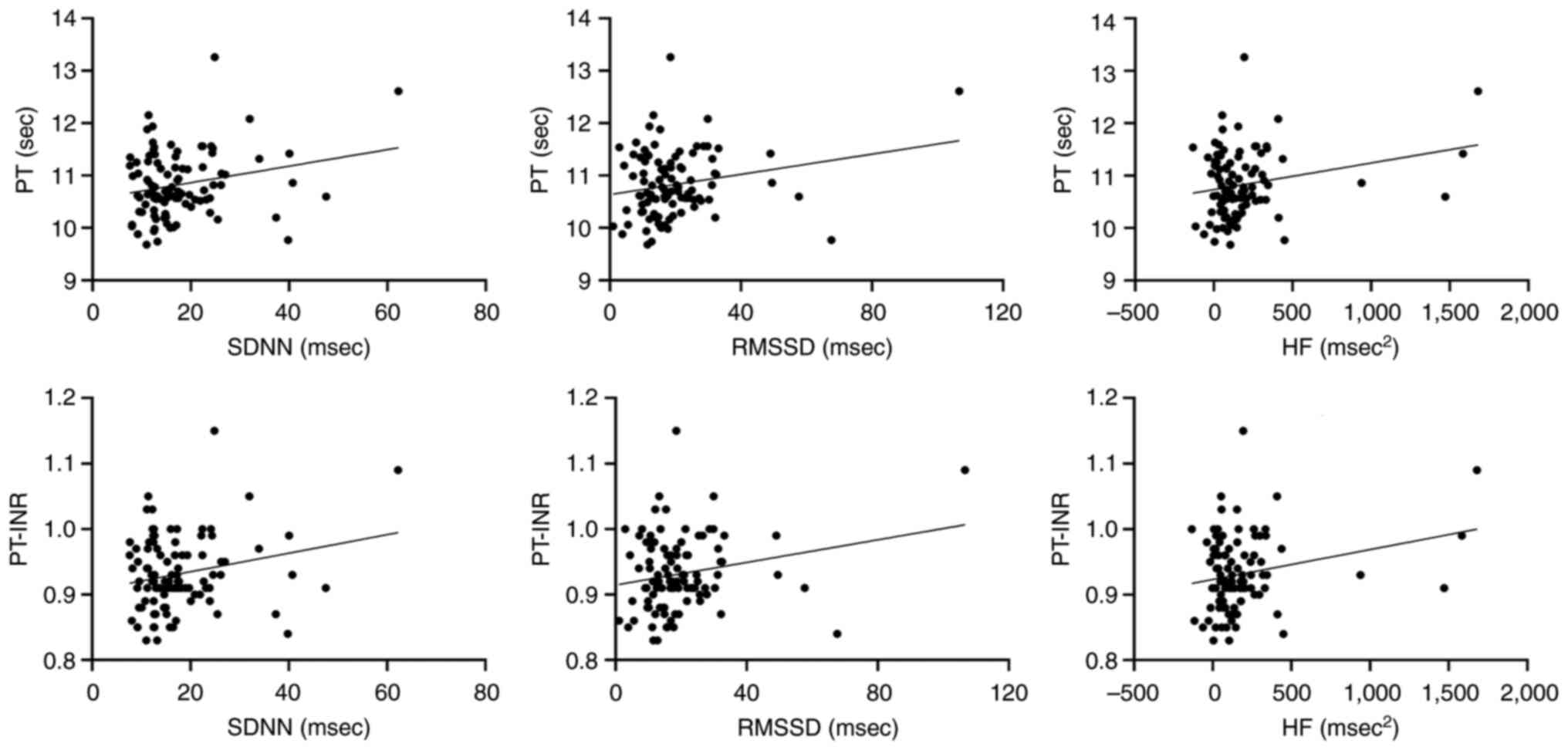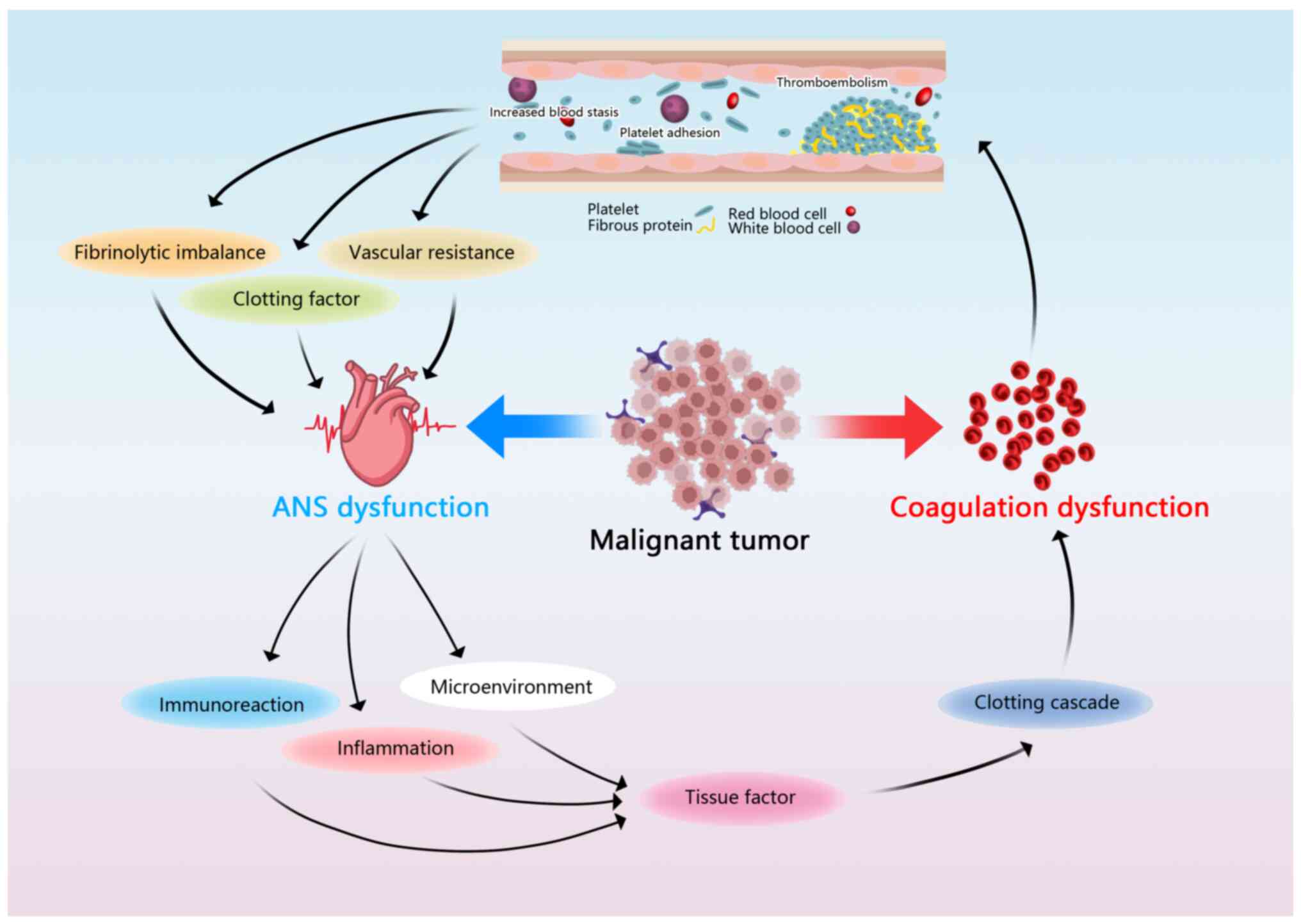|
1
|
Sung H, Ferlay J, Siegel RL, Laversanne M,
Soerjomataram I, Jemal A and Bray F: Global cancer statistics 2020:
GLOBOCAN estimates of incidence and mortality worldwide for 36
cancers in 185 countries. CA Cancer J Clin. 71:209–249. 2021.
View Article : Google Scholar : PubMed/NCBI
|
|
2
|
Wang X, Glubb DM and O'Mara TA: 10 years
of GWAS discovery in endometrial cancer: Aetiology, function and
translation. EBioMedicine. 77:1038952022. View Article : Google Scholar : PubMed/NCBI
|
|
3
|
Dhami SPS, Patmore S and O'Sullivan JM:
Advances in the management of cancer-associated thrombosis. Semin
Thromb Hemost. 47:139–149. 2021. View Article : Google Scholar : PubMed/NCBI
|
|
4
|
Thomas S and Krishnan A: Platelet
heterogeneity in myeloproliferative neoplasms. Arterioscler Thromb
Vasc Biol. 41:2661–2670. 2021. View Article : Google Scholar : PubMed/NCBI
|
|
5
|
Falanga A, Marchetti M and Vignoli A:
Coagulation and cancer: Biological and clinical aspects. J Thromb
Haemost. 11:223–233. 2013. View Article : Google Scholar : PubMed/NCBI
|
|
6
|
Li Q, Cong R, Kong F, Ma J, Wu Q and Ma X:
Fibrinogen is a coagulation marker associated with the prognosis of
endometrial cancer. Onco Targets Ther. 12:9947–9956. 2019.
View Article : Google Scholar : PubMed/NCBI
|
|
7
|
Ge L, Liu G, Hu K, Huang K, Zhang M, Zhou
J, Teng F, Cao J, Dai C and Jia X: A new risk index combining
d-Dimer, fibrinogen, HE4, and CA199 differentiates suspecting
endometrial cancer from patients with abnormal vaginal bleeding or
discharge. Technol Cancer Res Treat. 19:15330338199011172020.
View Article : Google Scholar : PubMed/NCBI
|
|
8
|
Kvolik S, Jukic M, Matijevic M, Marjanovic
K and Glavas-Obrovac L: An overview of coagulation disorders in
cancer patients. Surg Oncol. 19:e33–e46. 2010. View Article : Google Scholar : PubMed/NCBI
|
|
9
|
Adams SC, Schondorf R, Benoit J and
Kilgour RD: Impact of cancer and chemotherapy on autonomic nervous
system function and cardiovascular reactivity in young adults with
cancer: A case-controlled feasibility study. BMC Cancer.
15:4142015. View Article : Google Scholar : PubMed/NCBI
|
|
10
|
von Känel R and Dimsdale JE: Effects of
sympathetic activation by adrenergic infusions on hemostasis in
vivo. Eur J Haematol. 65:357–369. 2000. View Article : Google Scholar : PubMed/NCBI
|
|
11
|
Majerova K, Zvarik M, Ricon-Becker I,
Hanalis-Miller T, Mikolaskova I, Bella V, Mravec B and Hunakova L:
Increased sympathetic modulation in breast cancer survivors
determined by measurement of heart rate variability. Sci Rep.
12:146662022. View Article : Google Scholar : PubMed/NCBI
|
|
12
|
Zhou J, Liu Z, Zhang L, Hu X, Wang Z, Ni
H, Wang Y and Qin J: Activation of β2-adrenergic receptor promotes
growth and angiogenesis in breast cancer by down-regulating PPARγ.
Cancer Res Treat. 52:830–847. 2020. View Article : Google Scholar : PubMed/NCBI
|
|
13
|
Wojtukiewicz MZ, Sierko E, Klement P and
Rak J: The hemostatic system and angiogenesis in malignancy.
Neoplasia. 3:371–384. 2001. View Article : Google Scholar : PubMed/NCBI
|
|
14
|
Thaker PH, Han LY, Kamat AA, Arevalo JM,
Takahashi R, Lu C, Jennings NB, Armaiz-Pena G, Bankson JA, Ravoori
M, et al: Chronic stress promotes tumor growth and angiogenesis in
a mouse model of ovarian carcinoma. Nat Med. 12:939–944. 2006.
View Article : Google Scholar : PubMed/NCBI
|
|
15
|
Strous MTA, Daniels AM, Zimmermann FM, van
Erning FN, Gidron Y and Vogelaar FJ: Is pre-operative heart rate
variability a prognostic indicator for overall survival and cancer
recurrence in patients with primary colorectal cancer? PLoS One.
15:e02372442020. View Article : Google Scholar : PubMed/NCBI
|
|
16
|
Zhou X, Ma Z, Zhang L, Zhou S, Wang J,
Wang B and Fu W: Heart rate variability in the prediction of
survival in patients with cancer: A systematic review and
meta-analysis. J Psychosom Res. 89:20–25. 2016. View Article : Google Scholar : PubMed/NCBI
|
|
17
|
Cole SW, Nagaraja AS, Lutgendorf SK, Green
PA and Sood AK: Sympathetic nervous system regulation of the tumour
microenvironment. Nat Rev Cancer. 15:563–572. 2015. View Article : Google Scholar : PubMed/NCBI
|
|
18
|
Aeschbacher S, Schoen T, Dörig L,
Kreuzmann R, Neuhauser C, Schmidt-Trucksäss A, Probst-Hensch NM,
Risch M, Risch L and Conen D: Heart rate, heart rate variability
and inflammatory biomarkers among young and healthy adults. Ann
Med. 49:32–41. 2017. View Article : Google Scholar : PubMed/NCBI
|
|
19
|
Hu S, Lou J, Zhang Y and Chen P: Low heart
rate variability relates to the progression of gastric cancer.
World J Surg Oncol. 16:492018. View Article : Google Scholar : PubMed/NCBI
|
|
20
|
Bauer AT, Gorzelanny C, Gebhardt C, Pantel
K and Schneider SW: Interplay between coagulation and inflammation
in cancer: Limitations and therapeutic opportunities. Cancer Treat
Rev. 102:1023222022. View Article : Google Scholar : PubMed/NCBI
|
|
21
|
Wang L, Wang J, Li P, Wang X, Wu S and Shi
B: Association between short-term heart rate variability and blood
coagulation in patients with breast cancer. Sci Rep. 11:154142021.
View Article : Google Scholar : PubMed/NCBI
|
|
22
|
Berek JS, Matias-Guiu X, Creutzberg C,
Fotopoulou C, Gaffney D, Kehoe S, Lindemann K, Mutch D and Concin
N; Endometrial Cancer Staging Subcommittee and FIGO Women's Cancer
Committee, : FIGO staging of endometrial cancer: 2023. Int J
Gynaecol Obstet. 162:383–394. 2023. View Article : Google Scholar : PubMed/NCBI
|
|
23
|
Wierig M, Mandtler LP, Rottmann P, Stroh
V, Müller U, Büscher W and Plümer L: Recording heart rate
variability of dairy cows to the cloud-why smartphones provide
smart solutions. Sensors (Basel). 18:25412018. View Article : Google Scholar : PubMed/NCBI
|
|
24
|
Singh D, Vinod K and Saxena SC: Sampling
frequency of the RR interval time series for spectral analysis of
heart rate variability. J Med Eng Technol. 28:263–272. 2004.
View Article : Google Scholar : PubMed/NCBI
|
|
25
|
Welch P: The use of fast Fourier transform
for the estimation of power spectra: A method based on time
averaging over short, modified periodograms. IEEE Transactions on
Audio and Electroacoustics. 15:70–73. 1967. View Article : Google Scholar
|
|
26
|
Van Es N, Hisada Y, Di Nisio M, Cesarman
G, Kleinjan A, Mahé I, Otten HM, Kamphuisen PW, Berckmans RJ,
Büller HR, et al: Extracellular vesicles exposing tissue factor for
the prediction of venous thromboembolism in patients with cancer: A
prospective cohort study. Thromb Res. 166:54–59. 2018. View Article : Google Scholar : PubMed/NCBI
|
|
27
|
Rondon AMR, Kroone C, Kapteijn MY,
Versteeg HH and Buijs JT: Role of tissue factor in tumor
progression and cancer-associated thrombosis. Semin Thromb Hemost.
45:396–412. 2019. View Article : Google Scholar : PubMed/NCBI
|
|
28
|
Frischmuth T, Hindberg K, Aukrust P,
Ueland T, Braekkan SK, Hansen JB and Morelli VM: Elevated plasma
levels of plasminogen activator inhibitor-1 are associated with
risk of future incident venous thromboembolism. J Thromb Haemost.
20:1618–1626. 2022. View Article : Google Scholar : PubMed/NCBI
|
|
29
|
Hisada Y and Mackman N: Mechanisms of
cancer-associated thrombosis. Res Pract Thromb Haemost.
7:1001232023. View Article : Google Scholar : PubMed/NCBI
|
|
30
|
Braun A, Anders HJ, Gudermann T and
Mammadova-Bach E: Platelet-cancer interplay: Molecular mechanisms
and new therapeutic avenues. Front Oncol. 11:6655342021. View Article : Google Scholar : PubMed/NCBI
|
|
31
|
Moik F and Ay C: Hemostasis and cancer:
Impact of haemostatic biomarkers for the prediction of clinical
outcomes in patients with cancer. J Thromb Haemost. 20:2733–2745.
2022. View Article : Google Scholar : PubMed/NCBI
|
|
32
|
Bian J, Sun X, Li B and Ming L: Clinical
significance of serum HE4, CA125, CA724, and CA19-9 in patients
with endometrial cancer. Technol Cancer Res Treat. 16:435–439.
2017. View Article : Google Scholar : PubMed/NCBI
|
|
33
|
Lauer MS: Autonomic function and
prognosis. Cleve Clin J Med. 76 (Suppl 2):S18–S22. 2009. View Article : Google Scholar : PubMed/NCBI
|
|
34
|
Cheng Y, Sun F, D'Souza A, Dhakal B,
Pisano M, Chhabra S, Stolley M, Hari P and Janz S: Autonomic
nervous system control of multiple myeloma. Blood Rev.
46:1007412021. View Article : Google Scholar : PubMed/NCBI
|
|
35
|
Sloan EK, Priceman SJ, Cox BF, Yu S,
Pimentel MA, Tangkanangnukul V, Arevalo JM, Morizono K, Karanikolas
BD, Wu L, et al: The sympathetic nervous system induces a
metastatic switch in primary breast cancer. Cancer Res.
70:7042–7052. 2010. View Article : Google Scholar : PubMed/NCBI
|
|
36
|
Chang A, Sloan EK, Antoni MH, Knight JM,
Telles R and Lutgendorf SK: Biobehavioral pathways and cancer
progression: Insights for improving well-being and cancer outcomes.
Integr Cancer Ther. 21:153473542210960812022. View Article : Google Scholar : PubMed/NCBI
|
|
37
|
Rak J, Yu JL, Klement G and Kerbel RS:
Oncogenes and angiogenesis: Signaling three-dimensional tumor
growth. J Investig Dermatol Symp Proc. 5:24–33. 2000. View Article : Google Scholar : PubMed/NCBI
|
|
38
|
Heissig B, Eiamboonsert S, Salama Y,
Shimazu H, Dhahri D, Munakata S, Tashiro Y and Hattori K: Cancer
therapy targeting the fibrinolytic system. Adv Drug Deliv Rev.
99:172–179. 2016. View Article : Google Scholar : PubMed/NCBI
|
|
39
|
Szewczyk G, Maciejewski TM and Szukiewicz
D: Current progress in the inflammatory background of angiogenesis
in gynecological cancers. Inflamm Res. 68:247–260. 2019. View Article : Google Scholar : PubMed/NCBI
|
|
40
|
Tiwari R, Kumar R, Malik S, Raj T and
Kumar P: Analysis of heart rate variability and implication of
different factors on heart rate variability. Curr Cardiol Rev.
17:e1607211897702021. View Article : Google Scholar : PubMed/NCBI
|
|
41
|
Lee DY, Lee MY, Cho JH, Kwon H, Rhee EJ,
Park CY, Oh KW, Lee WY, Park SW, Ryu S and Park SE: Decreased vagal
activity and deviation in sympathetic activity precedes development
of diabetes. Diabetes Care. 43:1336–1343. 2020. View Article : Google Scholar : PubMed/NCBI
|
|
42
|
Katayama M, Kubo T, Yamakawa T, Fujiwara
K, Nomoto K, Ikeda K, Mogi K, Nagasawa M and Kikusui T: Emotional
contagion from humans to dogs is facilitated by duration of
ownership. Front Psychol. 10:16782019. View Article : Google Scholar : PubMed/NCBI
|
|
43
|
Dorgalaleh A, Favaloro EJ, Bahraini M and
Rad F: Standardization of prothrombin time/international normalized
ratio (PT/INR). Int J Lab Hematol. 43:21–28. 2021. View Article : Google Scholar : PubMed/NCBI
|
|
44
|
Tripodi A, Caldwell SH, Hoffman M, Trotter
JF and Sanyal AJ: Review article: The prothrombin time test as a
measure of bleeding risk and prognosis in liver disease. Aliment
Pharmacol Ther. 26:141–148. 2007. View Article : Google Scholar : PubMed/NCBI
|
|
45
|
Dirix LY, Oeyen S, Buys A, Liégois V,
Prové A, Van De Mooter T, Van Laere S and Vermeulen PB:
Coagulation/fibrinolysis and circulating tumor cells in patients
with advanced breast cancer. Breast Cancer Res Treat. 192:583–591.
2022. View Article : Google Scholar : PubMed/NCBI
|
|
46
|
Ricon-Becker I, Fogel E, Cole SW, Haldar
R, Lev-Ari S and Gidron Y: Tone it down: Vagal nerve activity is
associated with pro-inflammatory and anti-viral factors in breast
cancer-An exploratory study. Compr Psychoneuroendocrinol.
7:1000572021. View Article : Google Scholar : PubMed/NCBI
|
|
47
|
Van den Berg YW, Osanto S, Reitsma PH and
Versteeg HH: The relationship between tissue factor and cancer
progression: Insights from bench and bedside. Blood. 119:924–932.
2012. View Article : Google Scholar : PubMed/NCBI
|
|
48
|
Sloan RP and Cole SW: Parasympathetic
neural activity and the reciprocal regulation of innate antiviral
and inflammatory genes in the human immune system. Brain Behav
Immun. 98:251–256. 2021. View Article : Google Scholar : PubMed/NCBI
|















